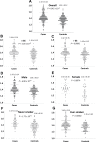γ-H2AX level in peripheral blood lymphocytes as a risk predictor for bladder cancer
- PMID: 23946494
- PMCID: PMC3810842
- DOI: 10.1093/carcin/bgt270
γ-H2AX level in peripheral blood lymphocytes as a risk predictor for bladder cancer
Abstract
Identification of susceptibility to double-strand breaks (DSBs) may provide valuable information about individual bladder cancer (BC) risk. The formation of γ-H2AX foci is a highly sensitive marker for DNA DSBs induction. We assessed whether levels of γ-H2AX in peripheral blood lymphocytes (PBL) obtained after stimulation by ionizing radiation (IR) are able to predict BC risk. Patients were enrolled from an ongoing BC case-control study. Baseline- and IR-induced H2AX phosphorylation was assessed in PBL from 174 newly diagnosed and untreated BC patients and from 174 matched control subjects by a novel, image-based, high-throughput phenotypic assay. The ratio of γ-H2AX level of IR-treated cells to that of non-treated cells (baseline) was used as the parameter to assess the sensitivity to the mutagen. The mean γ-H2AX ratios were significantly higher for cases than for controls (1.43±0.14 versus 1.35±0.12; P = 8.45×10(-8)). This trend was irrespective of age, sex and smoking status. The risk estimates of BC for induced DSBs by tertile distributions in controls showed also a significant trend for increased risk at the highest tertile for the whole cohort (odds ratio = 5.16; 95% confidence interval = 2.69, 9.89; P = 7.78 × 10(-7)) as well as for each category. Our findings suggest that a higher susceptibility to induction of DSBs as measured by the γ-H2AX assay is significantly associated with an increased risk for BC. This might help to identify individuals at high risk for this cancer, adding new perspectives to established epidemiological and genetic risk factors. Further research of the role of γ-H2AX in biological processes of BC is warranted.
Figures


Similar articles
-
H2AX phosphorylation level in peripheral blood mononuclear cells as an event-free survival predictor for bladder cancer.Mol Carcinog. 2016 Nov;55(11):1833-1842. doi: 10.1002/mc.22431. Epub 2015 Nov 19. Mol Carcinog. 2016. PMID: 27439749
-
Ionizing radiation-induced γ-H2AX activity in whole blood culture and the risk of lung cancer.Cancer Epidemiol Biomarkers Prev. 2013 Mar;22(3):443-51. doi: 10.1158/1055-9965.EPI-12-0794. Epub 2013 Jan 8. Cancer Epidemiol Biomarkers Prev. 2013. PMID: 23300022 Free PMC article.
-
Measurement of DNA damage in peripheral blood by the γ-H2AX assay as predictor of colorectal cancer risk.DNA Repair (Amst). 2017 May;53:24-30. doi: 10.1016/j.dnarep.2017.03.001. Epub 2017 Mar 6. DNA Repair (Amst). 2017. PMID: 28291710
-
Gamma histone 2AX (γ-H2AX)as a predictive tool in radiation oncology.Biomarkers. 2014 May;19(3):167-80. doi: 10.3109/1354750X.2014.898099. Epub 2014 Mar 10. Biomarkers. 2014. PMID: 24611829 Review.
-
Gamma-H2AX - a novel biomarker for DNA double-strand breaks.In Vivo. 2008 May-Jun;22(3):305-9. In Vivo. 2008. PMID: 18610740 Review.
Cited by
-
DNA repair phenotype and cancer risk: a systematic review and meta-analysis of 55 case-control studies.Sci Rep. 2022 Mar 1;12(1):3405. doi: 10.1038/s41598-022-07256-7. Sci Rep. 2022. PMID: 35233009 Free PMC article.
-
The Function of H2A Histone Variants and Their Roles in Diseases.Biomolecules. 2024 Aug 12;14(8):993. doi: 10.3390/biom14080993. Biomolecules. 2024. PMID: 39199381 Free PMC article. Review.
-
Post-Translational Modifications of H2A Histone Variants and Their Role in Cancer.Cancers (Basel). 2018 Feb 27;10(3):59. doi: 10.3390/cancers10030059. Cancers (Basel). 2018. PMID: 29495465 Free PMC article. Review.
-
Histone variants: The bricks that fit differently.J Biol Chem. 2025 Jan;301(1):108048. doi: 10.1016/j.jbc.2024.108048. Epub 2024 Dec 4. J Biol Chem. 2025. PMID: 39638247 Free PMC article. Review.
-
Roles of Histone H2A Variants in Cancer Development, Prognosis, and Treatment.Int J Mol Sci. 2024 Mar 9;25(6):3144. doi: 10.3390/ijms25063144. Int J Mol Sci. 2024. PMID: 38542118 Free PMC article. Review.
References
-
- Siegel R., et al. (2012). Cancer statistics, 2012. CA Cancer J. Clin., 62, 10–29 - PubMed
-
- Horner M., et al. (2009). SEER Cancer Statistics Review, 1975–2006. National Cancer Institute, Bethesda, MD
-
- Sylvester R.J., et al. (2006). Predicting recurrence and progression in individual patients with stage Ta T1 bladder cancer using EORTC risk tables: a combined analysis of 2596 patients from seven EORTC trials. Eur. Urol., 49, 466–47–5 - PubMed
-
- Shariat S.F., et al. (2006). Outcomes of radical cystectomy for transitional cell carcinoma of the bladder: a contemporary series from the Bladder Cancer Research Consortium. J. Urol., 176(6 Pt 1), 2414–24–22 - PubMed
-
- Stein J.P., et al. (2001). Radical cystectomy in the treatment of invasive bladder cancer: long-term results in 1,054 patients. J. Clin. Oncol., 19, 666–675 - PubMed
Publication types
MeSH terms
Substances
Grants and funding
LinkOut - more resources
Full Text Sources
Other Literature Sources
Medical
Molecular Biology Databases

